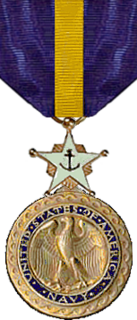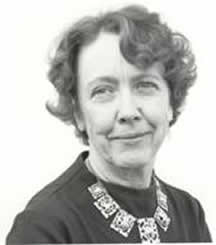Related Research Articles

The Silver Star Medal (SSM) is the United States Armed Forces' third-highest military decoration for valor in combat. The Silver Star Medal is awarded primarily to members of the United States Armed Forces for gallantry in action against an enemy of the United States.

The Navy Distinguished Service Medal is a military decoration of the United States Navy and United States Marine Corps which was first created in 1919 and is presented to sailors and Marines to recognize distinguished and exceptionally meritorious service to the United States while serving in a duty or position of great responsibility.

The NASA Distinguished Service Medal is the highest award that can be bestowed by the National Aeronautics and Space Administration of the United States. The medal may be presented to any member of the federal government, including both military astronauts and civilian employees.
This is a listing of recipients of the Boy Scouts of America Order of the Arrow's Distinguished Service Award (DSA). See Honors and awards of the Order of the Arrow for a description of the DSA.
Raymond Cecil Moore was an American geologist and paleontologist. He is known for his work on Paleozoic crinoids, bryozoans, and corals. Moore was a member of US Geological Survey from 1913 until 1949. In 1919 he became professor at the University of Kansas (Lawrence). In 1953 Professor Moore organized the launch and became the first editor of the still ongoing multi-volume work Treatise on Invertebrate Paleontology. Contributors to the Treatise have included the world's specialists in the field. He served as president of the Geological Society of America in 1958. In 1970 he was awarded the Mary Clark Thompson Medal from the National Academy of Sciences.

Andrew Herbert Knoll is the Fisher Research Professor of Natural History and a Research Professor of Earth and Planetary Sciences at Harvard University. Born in West Reading, Pennsylvania in 1951, Andrew Knoll graduated from Lehigh University with a Bachelor of Arts in 1973 and received his Ph.D. from Harvard University in 1977 for a dissertation entitled "Studies in Archean and Early Proterozoic Paleontology." Knoll taught at Oberlin College for five years before returning to Harvard as a professor in 1982. At Harvard, he serves in the departments of Organismic and Evolutionary Biology and Earth and Planetary Sciences.
The Society for Sedimentary Geology is an international not-for-profit, scientific society based in Oklahoma. It is commonly referred to by its acronym SEPM, which refers to its former name, the Society of Economic Paleontologists and Mineralogists.
The William H. Twenhofel Medal is the highest award given by the Society for Sedimentary Geology (SEPM). It was instituted in memory of William H. Twenhofel and is awarded annually to a person for his or her "Outstanding Contributions to Sedimentary Geology."
Alan H. Cheetham is a paleobiologist and retired senior scientist and curator of invertebrate paleontology at the Smithsonian Institution's National Museum of Natural History.
The George Westinghouse Medal is named for George Westinghouse and awarded to in honor of "eminent achievement or distinguished service in the power field of mechanical engineering" by the American Society of Mechanical Engineers. There is a Gold medal and a Silver medal. The silver medal may only be awarded to someone under 45 years of age.
Carterina is a genus in the Carterinida. The type species is Carterina spiculotesta Brady, 1884. The genus is described from specimens gathered during the Challenger expedition's circumnavigation of the Earth from 1872-1876.
The Mary Clark Thompson Medalis awarded by the U.S. National Academy of Sciences "for most important service to geology and paleontology." Named after Mary Clark Thompson and first awarded in 1921, it was originally presented every three years together with a $15,000 prize.
The Kirk Bryan Award is the annual award of the Quaternary Geology and Geomorphology Division of the Geological Society of America. It is named after Kirk Bryan a pioneer in geomorphology of arid regions. The award was established in 1951 and is bestowed upon the author or authors of a published paper of distinction advancing the science of geomorphology or some related field.

Helen Niña Tappan Loeblich was an American micropaleontologist who was a professor of geology at the University of California, Los Angeles, a United States Geological Survey (USGS) biostratigrapher, and a scientific illustrator whose micropaleontology specialty was research on Cretaceous foraminifera.
Alfred R. Loeblich Jr (1914–1994) was an American micropaleontologist. He was married to Helen Niña Tappan Loeblich and the two co-authored a number of important works on the Foraminifera and related organisms.
David L. Clark is a paleontologist. He was the W.H. Twenhofel Professor of Geology and Geophysics at the University of Wisconsin–Madison, Madison, Wisconsin.
William Henry Twenhofel was an American sedimentary geologist who wrote a landmark text Treatise on Sedimentation (1926) which went into more editions. He served for many years as a professor of geology at the University of Wisconsin. The Society of Economic Paleontologists and Mineralogists instituted the Twenhofel Medal in his memory.
References
- ↑ "Raymond C. Moore Medal for Paleontology". Society for Sedimentary Geology. Retrieved 19 February 2015.
- ↑ "Meet UCR's paleontology power pair".